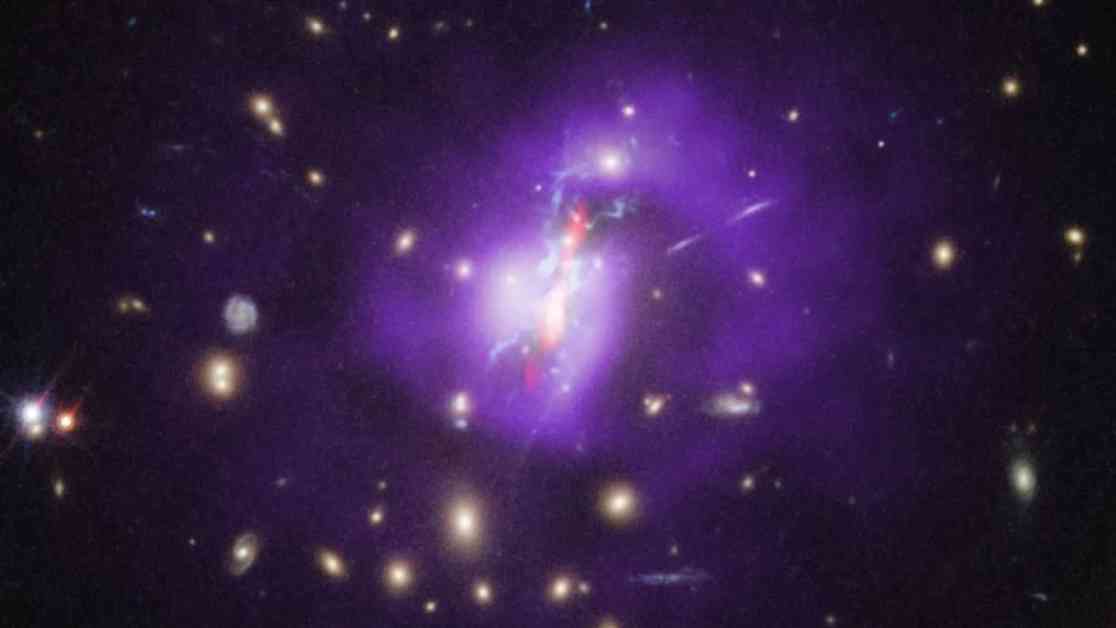Unlocking the Mysteries of Star Formation in the Phoenix Cluster
A cosmic ‘Phoenix’ is not just a mythical bird of fire and rebirth, but also a real phenomenon in the universe. Astronomers have long been puzzled by the extreme cooling of gas in the Phoenix cluster, a group of galaxies 5.8 billion light-years away. Stars can only form when gas cools enough to clump together, making the Phoenix cluster a hotbed for star formation. What makes this cluster unique is the presence of a supermassive black hole 10 billion times the mass of the sun at its core. This black hole should be preventing star formation by driving away gas and keeping it hot, but somehow, stars continue to form at a rapid pace.
The Mystery of the Phoenix Cluster Unraveled
The James Webb Space Telescope (JWST) has now shed light on this cosmic conundrum. Building upon previous studies using the Hubble Space Telescope, the Chandra X-ray Observatory, and ground-based observatories, astronomers have discovered the missing link in the cooling process that leads to star formation in the Phoenix cluster. Michael McDonald, a researcher at the Massachusetts Institute of Technology, likens the cluster to a ski slope where not all the gas was cooling to low temperatures, akin to missing skiers trapped midway down the slope.
Using the JWST’s Mid-Infrared Instrument (MIRI), researchers were able to collect detailed spectroscopic data from the Phoenix cluster, revealing the presence of “missing” cooling gas with temperatures around 540,000 degrees Fahrenheit. This gas was found within cavities in the cluster, tracing both extremely hot and cooled gas. The sensitivity of MIRI, combined with the unique characteristics of the Phoenix Cluster, allowed researchers to detect this previously elusive warm gas for the first time.
A Breakthrough in Astrophysical Observation
The discovery of the cooling gas in the Phoenix Cluster marks a significant breakthrough in astrophysical observation. By utilizing the JWST’s capabilities to detect neon and oxygen atoms in the infrared spectrum, researchers were able to uncover the hidden mechanisms of star formation in this massive galaxy cluster. The team’s research, published in the journal Nature, showcases the power of cutting-edge technology in unraveling the mysteries of the cosmos.
Looking Ahead: A New Frontier in Galaxy Cluster Studies
While the Phoenix Cluster remains a unique object of study, researchers are now applying their findings to other galaxy clusters using the JWST’s “proof of concept” technique. By studying the cooling processes in different environments, astronomers hope to gain a deeper understanding of star formation on a cosmic scale. The sensitivity of MIRI to infrared emissions from ionized neon and oxygen atoms opens up a new frontier in galaxy cluster studies, promising further insights into the complex interplay of gas dynamics, black hole activity, and star formation in the universe.
In conclusion, the discovery of cooling gas in the Phoenix Cluster highlights the importance of interdisciplinary collaboration and technological innovation in advancing our understanding of the cosmos. By peering into the depths of space with cutting-edge instruments like the JWST, astronomers continue to unlock the secrets of star formation and galactic evolution, paving the way for new discoveries and insights into the nature of our universe.










